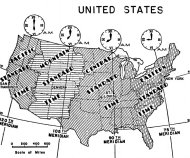
Worksheets and No Prep Teaching Resources
Reading Comprehension Worksheets
Geography

Geography
 Worksheets and No Prep Teaching Resources Reading Comprehension Worksheets Geography |
 Geography |
| edHelper's suggested reading level: | grades 5 to 7 | |
| Flesch-Kincaid grade level: | 4.59 |
|
Earth Movements and Time Zones
By Trista L. Pollard |

|
 1 Every day you wake up to the sun in the morning sky. When you go to sleep, you are covered by the Earth's darkness. Day and night are made possible by the Earth's rotation. Thanks to observation and astronauts, geographers have learned valuable information about how Earth moves.
1 Every day you wake up to the sun in the morning sky. When you go to sleep, you are covered by the Earth's darkness. Day and night are made possible by the Earth's rotation. Thanks to observation and astronauts, geographers have learned valuable information about how Earth moves. |
Create Weekly Reading Books
Prepare for an entire week at once! |
| Leave your feedback on Earth Movements and Time Zones (use this link if you found an error in the story) |
 |
Geography
|